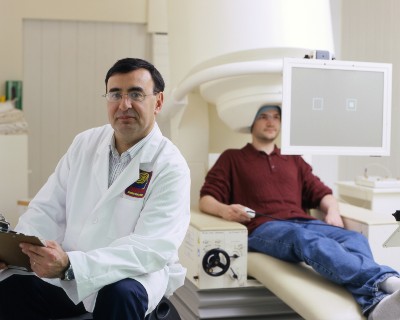Cracking the Ketamine Code
• Feature Story • 75th Anniversary
At a Glance
- Treatment-resistant depression affects nearly 3 million people in the United States.
- While monoaminergic antidepressants have been around for years, they don’t help everyone. In the early 2000s, researchers began looking at ketamine as a possible treatment.
- Decades of NIMH-supported research led to the 2019 approval of esketamine for treatment-resistant depression. Researchers continue to look for ways to deliver the treatment to patients who need it.
When he arrived at the National Institute of Mental Health (NIMH) in 2001, Carlos Zarate, M.D., had no idea he would take part in discovering a new treatment for an illness that—by definition—defies treatment. All he knew was that there were still people who needed help. They were people like Michelle, who developed treatment-resistant depression (TRD) after the death of her oldest son. The illness is a persistent and debilitating form of major depressive disorder that doesn’t improve after trying at least two antidepressants.

“I lost interest in everything, including my friends, family, and hobbies—even the blue sky and the sun,” Michelle said. “Nothing was pleasurable anymore.”
Like others with TRD, Michelle would take a new medication and wait, enduring the often-considerable side effects, sometimes for more than a month. When the drugs failed, she repeated this process—each time hoping this could be the one. The cycle continued for 2 years.
“I felt extremely hopeless and just empty,” she said. “I didn’t think I’d ever feel okay again.”
She’s not alone. TRD affects millions —and for those fortunate enough to find a treatment that works—up to 80% will relapse . It’s a pattern Dr. Zarate said can last decades, and one that places some people with the illness at risk for suicide.
While advances through NIMH-supported research would allow Dr. Zarate and other researchers to help people like Michelle, the solution—in an anesthetic known as ketamine—would take more than half a century to uncover.
Road to discovery
Born out of the need for a better anesthetic, researchers created ketamine in 1962. While the drug showed promise in early human testing, it gave many people spacy, out-of-body-like experiences. Despite its dissociative properties—side effects that would later haunt ketamine—it proved a reliable anesthetic. Approved by the U.S. Food and Drug Administration (FDA) in 1970, clues to ketamine’s potential use for depression soon followed. But researchers didn’t start connecting the dots until the 2000s.
The reasons for this long gap aren’t entirely clear—a mystery Zarate acknowledged in a 2019 paper . Given that, at the time, psychedelic drugs were all the rage, Zarate ventured that ketamine’s potential for abuse “undermined its psychiatric utility.” While traces of early research hinted of ketamine’s potential as an antidepressant, it was deemed too risky and challenging for use in clinical settings at the time. Because of this, and a lack of a patent, there was little financial incentive to invest into further research, he wrote.
For depression treatment in the 1970s, monoaminergic antidepressants were the gold standard. First introduced in the 1950s, these medications increase the activity of the brain’s serotonin, norepinephrine, and dopamine neurotransmitters. But while monoaminergic antidepressants were the treatment of choice, they didn’t work for everyone, and by the 1990s, development and improvement in the field had slowed. For people with TRD, researchers would need to discover something new.
It wasn’t until 1990—nearly 30 years after ketamine’s creation—that researchers under Phil Skolnick, Ph.D., D.Sc., at the National Institute of Diabetes and Digestive and Kidney Diseases made a breakthrough. The team uncovered a clue in N-methyl-D-aspartate (NMDA), the brain’s receptor for the neurotransmitter glutamate. By exposing mice to inescapable stressful events that produced signs similar to depression, researchers found that antagonists, or drugs that block NMDA could reduce those symptoms. Of the findings, they wrote that these drugs “may represent a new class of antidepressants.” While other animal-based studies of NMDA receptor antagonists followed, it would take another decade before researchers made significant headway.
Advancing the science

Aware of Dr. Skolnick’s findings, at Yale University, John Krystal, M.D., Ph.D., and Dennis Charney, M.D., wanted to learn more about the role of brain glutamate systems like NMDA in depression. The Yale team knew ketamine blocked NMDA and had psychological effects on people, and they suspected that ketamine could play a role in treating depression.
In 2000, a decade after Dr. Skolnick’s study, the Yale team completed the first randomized, controlled trial of single-dose intravenous ketamine in people with depression. Supported in part by NIMH, the study’s findings marked a paradigm shift: while established antidepressants could take over a month to work, intravenous ketamine worked within hours.
Hours.
Recognizing the study’s significance, Dr. Zarate joined NIMH’s Intramural Research Program in 2001. The program was staffed by Dr. Charney and Husseini Manji, M.D., who was later part of team that helped bring a form of ketamine for depression to market. It was the start of something new, and a venture that would put researchers closer to cracking the ketamine code.
All the clues pointed to ketamine. But as Dr. Zarate tells it, there were problems with moving the science forward. Researchers were working with a powerful anesthetic that, if administered incorrectly, could have severe consequences. While others might have given up, the NIMH team began studying people with TRD. Together in 2006, they safely and successfully replicated and expanded on the Yale findings. The results were better than the skeptics—even the patients—could’ve hoped for: 71% of participants who received intravenous ketamine reported feeling better.

Two NIMH controlled studies followed, both confirming the 2006 data. As news of the breakthrough spread, scientists across the nation conducted further ketamine studies which supported ketamine’s use not only for TRD, but also, for treating bipolar depression and reducing suicidal thoughts. Soon, physicians began prescribing ketamine off-label for TRD. The practice, usually done as a last resort, allows doctors to prescribe medication for conditions other than what the FDA originally approved.
The development of off-label ketamine has helped thousands of people, Dr. Zarate said. For proof, he only needs to look to Michelle, who recently participated in a life-changing NIMH ketamine study.
“It’s really quick, and it’s so noticeable to go from feeling so depressed to having your mood feel better,” Michelle said of ketamine treatment. "It feels like the depression was essentially removed, and I was returned to life again.”
Delivering treatment
While ketamine works quickly and when other antidepressants don’t, it’s not without flaw. Ketamine doesn’t work with everyone: about half the people who take it find relief. The side effects of ketamine as an anesthetic also apply to it as an antidepressant. Many patients experience short-lived disorienting, psychedelic symptoms on ketamine, and there’s a risk for misuse. Further, ketamine’s intravenous delivery requirement can make it expensive and inconvenient. There are also concerns about ketamine’s safety and the effects of its long-term use.
While these factors left ketamine as an antidepressant less than ideal, they didn’t leave it dead in the water. Researchers can attempt to modify an existing drug to improve it. The process is harder in practice than it sounds, but it’s what Dr. Manji, who left NIMH in 2008, set out to do. Wanting to improve barriers to access, Dr. Manji’s team began exploring delivering ketamine through the nose as a spray. But for it to work, they would need a stronger version of the drug.
Knowing ketamine is an equal mixture of two mirror-opposite compounds, R-ketamine and S-ketamine, Dr. Manji’s team focused on isolating pure S-ketamine. From there, they developed esketamine, which didn’t require intravenous administration.
In 2018, Dr. Manji’s team completed the first clinical study on intranasal esketamine for patients with TRD. The results showed that patients who took esketamine with their existing antidepressants found relief quickly, and that repeat doses of esketamine could stave off depressive symptoms for over 2 months. Then, in 2019—nearly 60 years after ketamine’s creation, Dr. Manji’s team met with success—in full FDA approval of esketamine for TRD. For people with the illness, the moment wasn’t life-changing; it was lifesaving.
“We’re optimistic that, given the unmet need among people with treatment-resistant forms of depression, which are millions of people in the United States alone, this will be a treatment that helps many, many people and starts to give them their lives back,” Dr. Manji told NIMH in 2019.
On the horizon
It took an orchestrated effort among government, academia, and industry decades to crack the ketamine code. Those efforts now give hope to thousands of people; some who just 10 years ago, had nothing left to lose.
Wanting to improve ketamine’s safety and barriers to access, Dr. Zarate and his NIMH colleagues are continuing their work. Together, with the National Center for Advancing Translational Sciences, the National Institute on Aging, and the University of Maryland School of Medicine, they’re researching a promising new drug , dubbed the “son of ketamine.” The drug may help with depression without the side effects, and Dr. Zarate’s optimistic it will be ready for clinical trials soon.
For Dr. Zarate, it’s not about the prestige that comes with developing a new treatment. It was never about that. It’s about changing lives and helping people like Michelle. His goal now, as it was all those years ago, is to give his patients hope.
“My reward,” he said, “is to really see my patients getting better and smiling.”
To learn more about Dr. Zarate’s work with ketamine, listen to NIMH’s podcast, “Depression: The Case for Ketamine.”
Publications
Berman, R. M., Cappiello, A., Anand, A., Oren, D. A., Heninger, G. R., Charney, D. S., & Krystal, J. H. (2000). Antidepressant effects of ketamine in depressed patients. Biological Psychiatry, 47(4), 351-354. https://doi.org/10.1016/s0006-3223(99)00230-9
Daly, E. J., Singh, J. B., Fedgchin, M., Cooper, K., Lim, P., Shelton, R. C., Thase, M. E., Winokur, A., Van Nueten, L., Manji, H., & Drevets, W. C. (2018). Efficacy and safety of intranasal esketamine adjunctive to oral antidepressant therapy in treatment-resistant depression: A randomized clinical trial. JAMA Psychiatry, 75(2), 139-148. https://doi.org/10.1001/jamapsychiatry.2017.3739
Holtzheimer, P. E. (2010). Advances in the management of treatment-resistant depression. Focus, 8(4), 488-500. https://doi.org/10.1176%2Ffoc.8.4.foc488
Trullas, R., & Skolnick, P. (1990). Functional antagonists at the NMDA receptor complex exhibit antidepressant actions. European Journal of Pharmacology, 185(1), 1-10. https://doi.org/10.1016/0014-2999(90)90204-j
Zanos, P., Moaddel, R., Morris, P. J., Georgiou, P., Fischell, J., Elmer, G. I., Alkondon, M., Yuan, P., Pribut, H. J., Singh, N. S., Dossou, K. S., Fang, Y., Huang, X. P., Mayo, C. L., Wainer, I. W., Albuquerque, E. X., Thompson, S. M., Thomas, C. J., Zarate, C. A., Jr., & Gould, T. D. (2016). NMDAR inhibition-independent antidepressant actions of ketamine metabolites. Nature, 533(7604), 481-486. https://doi.org/10.1038/nature17998
Zarate, C. A., Jr., Singh, J. B., Carlson, P. J., Brutsche, N. E., Ameli, R., Luckenbaugh, D. A., Charney, D. S., & Manji, H. K. (2006). A randomized trial of an N-methyl-D-aspartate antagonist in treatment-resistant major depression. Archives of General Psychiatry, 63(8), 856-864. https://doi.org/10.1001/archpsyc.63.8.856
Zhdanava, M., Pilon, D., Ghelerter, I., Chow, W., Joshi, K., Lefebvre, P., & Sheehan, J. J. (2021). The prevalence and national burden of treatment-resistant depression and major depressive disorder in the United States. The Journal of Clinical Psychiatry, 82(2), 29169. https://doi.org/10.4088/jcp.20m13699
Learn more
- NIMH Health Information Page: Depression
- NIMH Intramural Research Program Webpage: Carlos Zarate Jr., M.D. Bio
- NIMH Directors Message: New Hope for Treatment-Resistant Depression: Guessing Right on Ketamine
- NIMH Statistics Page: Major Depression
- NIMH Publications: Depression Fact Sheets, Brochures, Infographics
